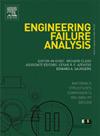热-力耦合作用下镐对砾岩磨损退化分析
IF 5.7
2区 工程技术
Q1 ENGINEERING, MECHANICAL
引用次数: 0
摘要
为了弄清镐的硬岩破磨退化机理,利用国产镐磨损试验机对镐从原始阶段到完全失效进行了全周期磨损试验。通过监测镐片的磨损质量、整体形貌、振动加速度和热像图,分析镐片在破岩过程中的热-力耦合退化行为。此外,通过观察岩屑、磨损云图和微观磨损形态,进一步揭示了镐的磨损机理。结果表明,镐在完全失效前经历了四个阶段:(Ⅰ)自锐化、(Ⅱ)镐体变薄、(Ⅲ)镐尖脱落和(Ⅳ)镐体严重磨损。Ⅰ和Ⅳ阶段的截齿质量磨损率和温升高于Ⅱ和Ⅲ阶段。此外,振动加速度的波形和过零率(ZCR)在各个阶段都有变化Ⅲ。因此,温度和振动加速度可作为镐失效的判断指标。镐尖的主要磨损机制是冲击磨损,但由于其硬度高,体积损失小。镐体的磨损机制转变为磨粒磨损和氧化磨损。岩屑在不同地区、不同阶段发挥着不同的作用。高温会使镐体基体软化,促进岩屑作用。本文章由计算机程序翻译,如有差异,请以英文原文为准。
Wear degradation analysis of pick against conglomerate under thermo-mechanical coupling
To clarify the hard rock breaking wear degradation mechanism of the pick, a full-cycle wear test of the pick from the original stage to complete failure was conducted using a home-made pick wear tester. The thermo-mechanical coupling degradation behavior of the pick during the rock-breaking process was analyzed by monitoring the wear mass, overall morphology, vibration acceleration, and thermogram. In addition, rock debris, wear nephogram, and microscopic wear morphology were observed to further reveal the wear mechanism of the pick. Results indicate that the pick experiences four stages before complete failure: (Ⅰ) self-sharpening, (Ⅱ) pick body thinning, (Ⅲ) pick tip detachment, and (Ⅳ) severe pick body wear. The mass wear rate and temperature rise of the pick in stages Ⅰ and Ⅳ are higher than those in stages Ⅱ and Ⅲ. Besides, the waveform and zero-crossing rate (ZCR) of vibration acceleration change in stage Ⅲ. Therefore, temperature and vibration acceleration can be used as a judgment for pick failure. The dominant wear mechanism of the pick tip is impact wear, but the volume loss is low due to its high hardness. The wear mechanism of the pick body changes to abrasive and oxidative wear. The rock debris plays various roles in different regions and stages. High temperature will cause the pick body matrix to soften and promote the rock debris action.
求助全文
通过发布文献求助,成功后即可免费获取论文全文。
去求助
来源期刊

Engineering Failure Analysis
工程技术-材料科学:表征与测试
CiteScore
7.70
自引率
20.00%
发文量
956
审稿时长
47 days
期刊介绍:
Engineering Failure Analysis publishes research papers describing the analysis of engineering failures and related studies.
Papers relating to the structure, properties and behaviour of engineering materials are encouraged, particularly those which also involve the detailed application of materials parameters to problems in engineering structures, components and design. In addition to the area of materials engineering, the interacting fields of mechanical, manufacturing, aeronautical, civil, chemical, corrosion and design engineering are considered relevant. Activity should be directed at analysing engineering failures and carrying out research to help reduce the incidences of failures and to extend the operating horizons of engineering materials.
Emphasis is placed on the mechanical properties of materials and their behaviour when influenced by structure, process and environment. Metallic, polymeric, ceramic and natural materials are all included and the application of these materials to real engineering situations should be emphasised. The use of a case-study based approach is also encouraged.
Engineering Failure Analysis provides essential reference material and critical feedback into the design process thereby contributing to the prevention of engineering failures in the future. All submissions will be subject to peer review from leading experts in the field.
 求助内容:
求助内容: 应助结果提醒方式:
应助结果提醒方式:


